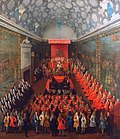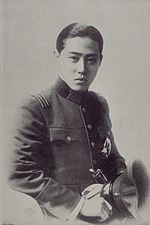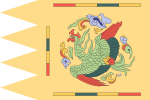Chinwang (친왕; 親王) of the Korean Empire. Some clans whose social rank throughout Korean history could be considered equivalent to nobility are as follows (this...
16 KB (2,065 words) - 13:25, 9 October 2024
Korean nobility Vietnamese nobility Malay nobility Mongolian nobility Ottoman titles Principalía of the Philippines Thai nobility Albanian nobility Austrian...
88 KB (10,360 words) - 22:33, 12 November 2024
Imperial, royal and noble ranks (redirect from Ranks of nobility and peerage)
Traditional rank amongst European imperiality, royalty, peers, and nobility is rooted in Late Antiquity and the Middle Ages. Although they vary over time...
76 KB (9,787 words) - 20:43, 21 November 2024
Yi Cheong (redirect from Chung, Prince of Korea)
1936) is a member of the former Imperial Family of Korea and was a Korean-Japanese noble during Korea under Japanese rule in 1945–1947. He is a great-great-grandson...
13 KB (1,537 words) - 10:13, 28 February 2024
Yi Seok (redirect from Seok, Prince of Korea)
Seok (Korean: 이석; born 3 August 1941) is a South Korean entrepreneur. He is a member of the House of Yi, the royal house of Joseon and Korean Empire...
19 KB (1,882 words) - 04:41, 12 November 2024
Yi U (redirect from Woo, Prince of Korea)
Colonel Prince Yi U (Korean: 이우; 15 November 1912 – 7 August 1945) was a member of the imperial family of Korea as a prince, the 4th head[clarification...
5 KB (416 words) - 21:00, 29 August 2024
common Chinese surname Titles in Chinese nobility A title in Korean nobility A title in Mongolian nobility Wang River in Thailand Wang Township, Minnesota...
2 KB (269 words) - 14:02, 14 April 2024
dynasty between 1885 and 1937: Chinese nobility Royal and noble ranks of the Qing dynasty Kazoku Korean nobility Styles and titles in the Joseon dynasty...
15 KB (1,025 words) - 16:42, 1 September 2024
High Korean may refer to: Yangban, the traditional Korean nobility In linguistics: Prestige dialects of the Korean language, namely: Seoul dialect, the...
316 bytes (71 words) - 23:34, 19 October 2023
Songbun (redirect from North Korean castes)
Songbun (Korean: 성분; MR: sŏngbun), formally chulsin-songbun (Korean: 출신성분; MR: ch'ulsin sŏngbun, from Sino-Korean 出身, "origin" and 成分, "constituent"),...
18 KB (2,005 words) - 13:42, 1 November 2024
Yi Un (redirect from Eun, Crown Prince of Korea)
Yi Un (Korean: 이은; 20 October 1897 – 1 May 1970) was the 28th Head of the Korean Imperial House, an Imperial Japanese Army general and the last Imperial...
18 KB (1,785 words) - 04:42, 12 November 2024
Son of Heaven (category Korean nobility)
Nonchong (in Korean) (49): 70–76. ISSN 1975-7840. Archived from the original on Apr 30, 2021. Retrieved 3 November 2018. "고구려의 천하관". 우리역사넷 (in Korean). National...
11 KB (1,159 words) - 08:05, 22 August 2024
Yangban (category Korean nobility)
The yangban (Korean: 양반; Hanja: 兩班) were part of the traditional ruling class or gentry of dynastic Korea during the Joseon period. The yangban were mainly...
24 KB (3,020 words) - 03:08, 22 November 2024
Republic of Korea (South Korea), or the "Great Han Republic", is named after the Korean Empire. Korean nobility List of monarchs of Korea The Chungju...
36 KB (4,389 words) - 07:19, 1 March 2024
House of Yi (redirect from Korean royalty)
incorporated into the royal family (王公族, Ōkōzoku) or made Korean nobles (朝鮮貴族, Chōsen-kizoku). The Korean nobility titles granted by Japan in 1910, listing only those...
60 KB (4,606 words) - 01:22, 10 November 2024
the Korean nobility or royalty. Comparisons of these sites have been made to other Japanese fortresses, and to sites of the same period in both Korea and...
9 KB (789 words) - 19:36, 13 May 2024
The Korean People's Army (KPA; Korean: 조선인민군; MR: Chosŏn inmin'gun) encompasses the combined military forces of North Korea and the armed wing of the...
75 KB (7,523 words) - 22:57, 12 November 2024
Goryeo (redirect from Korean Kingdom)
Goryeo (Korean: 고려; Hanja: 高麗; MR: Koryŏ; [ko.ɾjʌ]) was a Korean state founded in 918, during a time of national division called the Later Three Kingdoms...
130 KB (15,244 words) - 14:20, 19 November 2024
houses (hanok) “in a village setting designed to illustrate the way the Korean nobility lived during the Joseon dynasty”. Chyung Mi-sook had made the decision...
4 KB (464 words) - 02:55, 21 October 2024
Yi Geon (category Korean nobility)
Ken'ichi), was a Korean prince and a cavalry officer in the Imperial Japanese Army during World War II. The first son of Prince Yi Kang of Korea by Lady Jeong...
14 KB (1,765 words) - 16:40, 6 November 2024
Taesangwang (category Articles containing Korean-language text)
was Emperor Gojong in Korean Empire. Chungryeol Chungseon Chungsuk Taejo Jeongjong Taejong Danjong Sejo Gojong Korean nobility Taishang Huang Daijō Tennō...
2 KB (98 words) - 04:05, 4 October 2023
The nobility of China represented the upper strata of aristocracy in premodern China, acting as the ruling class until c. 1000 CE, and remaining a significant...
30 KB (3,711 words) - 13:35, 1 November 2024
Noblesse oblige (redirect from Nobility obligates)
əˈbliːʒ/; French: [la nɔblɛs ɔbliʒ] ; literally "nobility obliges") is a French expression that means that nobility extends beyond mere entitlement, requiring...
9 KB (1,003 words) - 13:58, 16 October 2024
Jeongak (category CS1 Korean-language sources (ko))
Korean traditional music, in contrast with minsogak or Korean traditional folk music. The genre has traditionally been associated with the nobility and...
2 KB (118 words) - 19:54, 17 June 2024
Unsourced material may be challenged and removed. Find sources: "LGBT nobility and royalty" – news · newspapers · books · scholar · JSTOR (November 2016)...
33 KB (3,803 words) - 15:19, 8 November 2024
Hanbok (redirect from Korean traditional clothing)
hanbok (Korean: 한복; Hanja: 韓服; lit. Korean dress) is the traditional clothing of the Korean people. The term hanbok is primarily used by South Koreans; North...
119 KB (13,148 words) - 21:07, 13 November 2024
Korean terms for names exist. For full names, seongmyeong (Korean: 성명; Hanja: 姓名), seongham (성함; 姓銜), or ireum (이름) are commonly used. When a Korean name...
58 KB (6,147 words) - 06:00, 12 November 2024
Four Gentlemen (category CS1 Korean-language sources (ko))
stone crafts such as inkstones and braziers. Within Korean folk painting (Chinese: 百童子圖; Korean: Baekdongjado): plum blossoms have come to symbolize...
6 KB (553 words) - 12:39, 16 October 2024
little mention of homosexuality in Korean literature or traditional historical accounts, several members of the nobility and Buddhist monks have been known...
115 KB (11,891 words) - 06:34, 20 November 2024
This is a list of fictional nobility that have appeared in various works of fiction. This list is organized by noble rank and limited to well-referenced...
78 KB (1,541 words) - 10:10, 19 November 2024

















